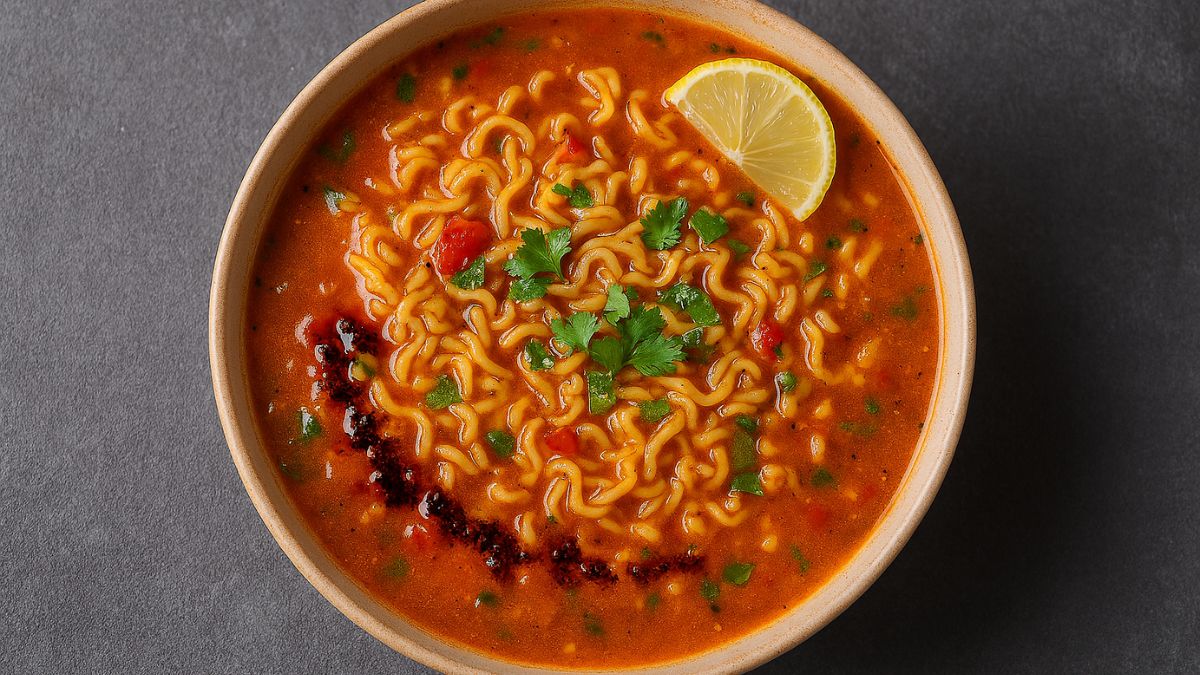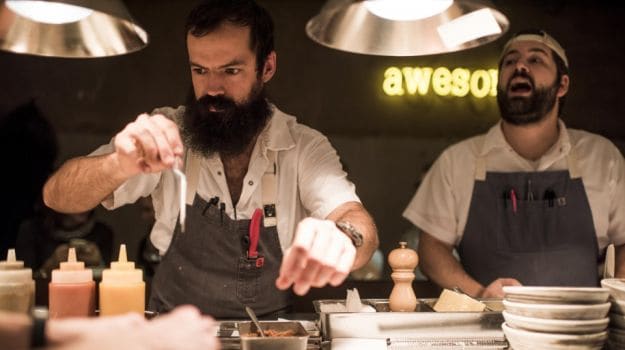PhotoCredit:TheWashingtonPostThere are two types of beards that can be found in restaurants. The first one is preceded by the word "James" and followed by the word "Award." The second type is where things get, well, a little hairy.
When The Washington Post ran an article on its front page about the Michelin Guide's arrival in D.C., several readers wrote to express concern that the two photos that accompanied the article showed chefs with uncovered hair and beards.
"I do hope that the chefs in the front and back page photographs simply removed their hairnets for the photos. Otherwise, it is very disturbing, particularly since all three men have quite the head and face full of hair; something I do not want to find in my food should I go there," wrote Francesca Marcus. "I am not inordinately fastidious, but I blanched at the sight of the three pictured chefs handling dishes without head or beard coverings or gloves," wrote Anneka Westall, in a letter to the editor published recently. The lack of hair nets and beard nets were addressed specifically by several letter writers.
Except, when was the last time you saw a hair or beard net in a restaurant - especially one serving food at any level above a corporate cafeteria? Baseball hats, yes. Beanies, increasingly. But for those of you who think that everyone preparing your food is wearing a hair net or beard net: Sorry to break it to you, but, um, they're not.
Hair restraints are required by the D.C. Department of Health, but they don't have to be a hairnet, specifically. Here's the relevant portion of the food code:
"Food employees shall wear clean and effective hair restraints, such as hairnets or beard nets, if appropriate, and clothing that covers body hair. . . . Hats, caps, scarves or other head covers are acceptable if the hair is contained to prevent contamination. Hair spray and tying back the hair in a ponytail are not effective hair restraints."
But if you've been in an upscale restaurant lately, you may have noticed that the days of tall French toques are long gone and that the executive chef, who oversees the final plating and garnishes on dishes and expedites the food, isn't always wearing a hat.
"My whole entire career, every chef I've worked for, they've never worn a hat," said Nicholas Stefanelli of Masseria in D.C., who was pictured on the front page of The Post plating a dish. (The cooks on the line, who do most of the food preparation at Masseria, wear caps.) "It's been 20 years that I've been following this path: Once you become a chef, you don't wear a hat anymore."
And beard nets? Chances are, a chef has never worn one.
"I've never seen a beard net outside of the military," said "Top Chef" competitor Chad White, whose 5-inch-long beard made him a memorable presence on Season 13. When he was a Navy cook, he wore one - because shaving irritates his skin, he received special permission to have facial hair in the military - but hasn't donned one since.
The beard net was "extremely uncomfortable," White said, and he thought it was more unhygenic than going bare. "Fuzzies from the beard net would fly everywhere."
In Spokane, Wash., where he lives, he estimates that about 10 percent of the chef community have long beards. Even though a 2014 study claimed we had reached "peak beard," whiskers seem as if they're here to stay. They're especially popular in D.C., too: Last year, a shaving company named Washington the number one most facial-hair-friendly city in the nation.
At Rose's Luxury, "most of the guys that work here have beards," said sous chef Seth Wells. The customers joke about it: "They're like, 'What, do you guys have to have a beard to work here?' "
But bearded chefs say they still have to fight stereotypes about cleanliness, especially amid headlines like "Some beards as dirty as toilets." That article, which said beard hairs contain the same bacteria found in feces, was debunked by a Slate science writer who pointed out that those same bacteria can be found all over our bodies and are not exclusive to beards.
"I'll post something on social media, and someone will be like, 'I can't believe you're a chef with a beard. That's disgusting,' " said White said.
In fact, because bearded men know they may be watched more closely, it's possible that they are more vigilant about cleanliness. Stefanelli holds them to a high standard: "We have an open kitchen. I make sure that our guys have meticulous grooming standards," he said.
Because, honestly, you're not likely to find a hair in your food at the restaurants discussed here. Accidents happen, of course, but high-profile, upscale restaurants have a reputation to uphold. Food "gets checked, double-checked, and the food runner is looking for it, too," Stefanelli said. "Everybody's always looking out to make sure the dishes are done the way they're supposed to be."
Anytime a plate has been sent back for a hair at Masseria, Stefanelli says it has been "somebody else's hair that's not in our kitchen, like a long red hair." They'll just take the hit. "We'll just recook everything."
And although the sight of it may turn your stomach, "The FDA has received no reports of people getting ill from ingesting hair found in food," reported Popular Science.
That's no consolation for some people. When he saw the photo of Wells in The Post, "I thought that probably, some of his whiskers were going to wind up in the food, and I wouldn't want to eat in a restaurant with that level of hygiene," said Charles Carron. "It would definitely be off-putting to me."
It's off-putting to the health department, too. The code's wording ("if appropriate") gives cooks some leeway, but Jasmine Gossett, public affairs specialist with the D.C. Department of Health, clarified that beard nets are necessary "when the beard is to the point at which it hangs off the face."
Some restaurant workers may be surprised to learn that this rule extends to servers and bartenders if they are involved in food preparation, "such as cutting fruit or bread."
"I think that that's the silliest thing I've ever heard," said Lukas B. Smith, who tends bar at Dram & Grain in the basement of Jack Rose, and is working to open the distillery Cotton & Reed later this year. "I'm not going to put on a beard net when I need to slice a lemon for an Old Fashioned." He suspects that the rule is not enforced, despite Gossett's assertions to the contrary. (He added: "If the health department calls Jack Rose and tells me that I have to wear a beard net, I'm calling you.")
And besides, wouldn't it kill the vibe if you were on a romantic date and a bartender made your drink in a surgical-style beard net? Some people might feel safer about their next sip of Negroni. But for others, it conjures up bad associations with middle-school cafeterias and industrial-style food.
"It would make the person wearing it not be taken seriously," said Andrew Freeman, a San Francisco-based restaurant consultant. "I think people are probably going to quit before they wear one of those."
Kitchens, in general, have gotten a lot more relaxed when it comes to appearances. Beards in the food and handicraft industry have come to signify a certain level of authenticity - remember the Mast Brothers? - and in a cool restaurant with industrial-rustic-chic decor, they're as expected as Mason jars and Edison bulbs.
Besides, if a beard is well cared-for, it's no more of a shedding threat to your salad than the hair on one's head, said Currie Corbin, editor-in-chief of Urban Beardsman, a men's fashion website owned by Beardbrand, a men's grooming company. The only occasion he could think of where a net would be necessary is "maybe if you had a beard down to your belly and you were working a mixer."
Unsurprisingly, he encourages bearded chefs and bartenders to "create a daily routine where you are cleaning and softening it, brushing it in the morning, using a beard oil that will help give a good texture and shape to the beard."
But he suspects they already are. Beardsmen, he says, are more likely to keep their beards "better maintained than the hair on their head." But that's no comfort to those for whom the sight of a beard in a kitchen makes their hair stand on end.
(c) 2016, The Washington Post(This story has not been edited by NDTV staff and is auto-generated from a syndicated feed.)













